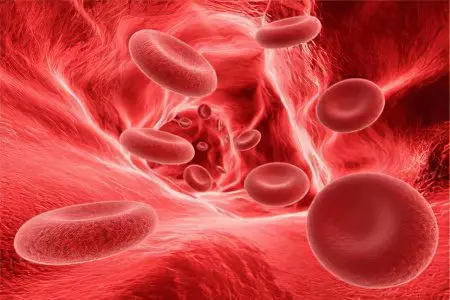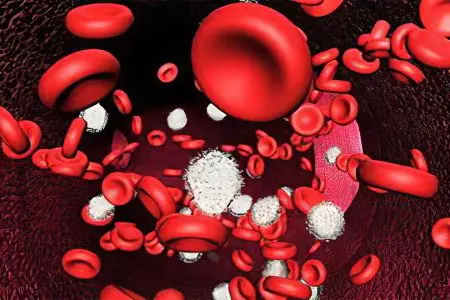Contents
Anemia is a pathological condition of the body, which is characterized by a decrease in the level of hemoglobin in the blood. If a person is diagnosed with anemia, then he needs treatment. It will depend on the severity of the violation, as well as on the cause that led to the drop in hemoglobin.
Severity of anemia by hemoglobin level

Anemia develops against the background of other diseases, acting as a pathological symptom of many disorders in the body. However, it is always accompanied by a decrease in the level of hemoglobin in the blood. As a result of such changes, organs and tissues begin to suffer from a lack of oxygen. Oxygen starvation is called hypoxia.
Normally, in adult men, the hemoglobin level should vary between 130-180 g / l. In women, this figure is 120-150 g / l.
If these values begin to decline, then doctors talk about anemia, which can have 3 degrees of severity:
The first degree of severity of anemia is characterized by a drop in hemoglobin levels to 90-120 g / l. This condition can be corrected by proper nutrition, hospitalization of the patient is not required.
Anemia of moderate severity develops when the hemoglobin level drops to 70-90 g/l. in this case, it will no longer be possible to get rid of the disorder only with the help of a diet; medication is required. If a person feels satisfactory, then he is not hospitalized.
The third degree of severity of anemia is characterized by a decrease in hemoglobin levels of less than 70 g / l. In this case, a person is placed in a hospital, where complex treatment is carried out. Depending on the cause that led to the development of anemia, therapy can be either conservative or surgical.
Anemia 1 mild degree

If a person develops mild grade 1 anemia, then there are usually no symptoms of the disorder. Therefore, the patient may not even suspect that he has pathological changes in the concentration of hemoglobin in the blood. This can be determined using laboratory tests.
Symptoms that may occur with mild anemia include:
Weakening of concentration.
Increased pulsation.
Deterioration in performance.
Weakening of memory.
Fatigue, a feeling of constant fatigue, despite proper rest.
Paleness of the skin and mucous membranes.
Orthostatic hypotension may be a sign of anemia of the first degree. At the same time, a person’s pressure drops when the body position changes (with a sharp rise from the bed), which is expressed in darkening in the eyes. Also at this time, an increase in heart rate is possible. This symptom is called orthostatic tachycardia.
From time to time, a person may be haunted by dizziness. Fainting for the first degree of anemia is not typical.
Reasons. The reasons for the development of anemia can only be determined by a doctor. To install them, you will need to donate blood. Iron deficiency anemia is the most common type of anemia in humans, where a lack of iron causes a drop in hemoglobin levels. After all, it is this microelement that is necessary for the normal production of Hb. According to average data, iron deficiency anemia affects up to 50% of children at an early age, up to 15% of women in the childbearing period of their lives and up to 2% of adult men. As the analysis of statistics shows, every 3rd inhabitant of the Earth has a latent tissue iron deficiency. From all types of anemia, it takes about 80-90%.
Sharply iron deficiency anemia develops rarely. First, a person has a so-called pre-latent iron deficiency. Microelement reserves are depleted only in tissues. As the disease progresses, the level of not only deposited, but also transport, as well as erythrocyte iron decreases. The severity of iron deficiency anemia can be minimal or completely hidden.
Treatment. Treatment of mild anemia requires nutritional correction, although it all depends on the causes that provoked this disorder. However, the diet of the patient will need to be observed without fail. It is followed until the level of hemoglobin in the blood returns to normal. Be sure to include in the menu products that are rich not only in iron, but also in vitamin B.
These foods include: red meat, fish, eggs, nuts, spinach, beets, pomegranates. Be sure to include tomatoes, carrots, fresh herbs, legumes (peas, lentils and beans), oatmeal, buckwheat, bread, honey in the diet. In order for iron to be better absorbed by the body, you should enrich your menu with foods that are rich in vitamin C. It increases the bioavailability of this trace element, which allows it to more easily penetrate into the blood. In addition, citric and succinic acid improves iron absorption. Succinic acid is present in sufficient quantities in kefir, curdled milk, sunflower oil, sunflower seeds, barley, Borodino bread, green gooseberries, apples, cherries, and grapes.
There are also foods that, on the contrary, slow down the absorption of iron. These are those drinks and dishes in which the content of tannin, polyphenols and oxalates is exceeded. Therefore, it is recommended to refrain from drinking coffee, tea, soy proteins, whole milk, chocolate.
If anemia of the first degree of severity is detected, treatment should not be delayed. Otherwise, the violation will progress and lead to serious consequences for the body. Self-selection of therapy is not allowed.
As a rule, taking medications for mild anemia is not required. They are prescribed only in the case when the correction of nutrition does not eliminate the existing problem. The doctor can prescribe medicines for a minimum period of 1,5 months and in minimal dosages. If after the specified time the hemoglobin level returns to normal, then the dose is halved and the treatment is continued for another month. This measure is aimed at consolidating the result. In addition to pure iron preparations, it is possible to prescribe multivitamin complexes, which must necessarily include iron and folic acid.
Often, patients with mild anemia are prescribed drugs such as:
Ferro-foil containing not only ferrous sulfate, but also ascorbic acid, folic acid and cyanocobalamin. With a mild degree of anemia, 1 capsule is prescribed 3 times a day. Take the drug after a meal.
Ferroplex is represented by a complex of ascorbic acid and iron sulfate. With a mild degree of anemia, 1 tablet is indicated 3 times a day.
Hemofer prolongatum is prescribed 1 tablet 1 time per day.
After the start of taking iron supplements, signs of anemia will be stopped already on the 3rd day of treatment, but this does not mean that it is time to stop therapy. Normalization of hemoglobin levels in the blood will occur no earlier than 6 weeks from the start of therapy.
Be sure to develop anemia of the first degree of severity should be checked for people at risk. They may not have symptoms of anemia, but their health status indicates a high likelihood of developing anemia. People at risk include:
Pregnant women.
Children under the age of 3 years. This is especially true for children born prematurely or with low body weight.
Children born as a result of multiple pregnancy.
Children born to a woman who suffered from anemia during pregnancy.
Children and adults with diagnosed helminthiases and diseases of the digestive system.
To prevent the development of mild anemia, you need to monitor your diet, and if you are at risk, regularly take blood tests to determine the level of hemoglobin.
Anemia 2 moderate

Anemia of moderate severity is characterized by a much more pronounced decrease in the level of hemoglobin in the blood, which causes the severity of symptoms. Now it will be impossible not to notice anemia.
Its symptoms are:
Frequent dizziness.
Insomnia with increased daytime sleepiness.
Lack of appetite.
The appearance of noise in the ears.
Increased shortness of breath. If earlier it arose only against the background of physical effort, or was completely absent, now shortness of breath will appear even at rest.
Tachycardia and arrhythmia.
Headache.
The appearance of “flies” before the eyes.
Swelling of the skin. In the morning, swelling under the eyes, the so-called “bags”, is especially noticeable.
Memory impairment
Joint problems.
Pale skin and pale mucous membranes. The skin becomes dry, prone to peeling, cracks form on it.
Hair turns gray before the due time, falls out more, becomes dull. The same applies to the nail plate. In patients with anemia, the nails become pale, lose their natural luster.
The skin becomes pasty in the area of the legs, face and feet.
Taste perversion is observed in many patients already in the second degree of anemia. At the same time, a person may feel the desire to eat clay, sand, ice, chalk, coal, raw dough, raw minced meat or cereals. Most often, taste perversion occurs in children, adolescents, and young women. They have increased cravings for sour, spicy and spicy foods.
Perversion of smell is possible. A person will begin to like to inhale aromas that disgust healthy people (acetone, paint, varnish, etc.).
The patient’s muscle strength is reduced.
In 10% of patients, angular stomatitis is observed, which is popularly known as “zaedy”.
There may be pain in the tongue, as well as a feeling of fullness of the tongue from the inside.
The eye sclera may acquire a bluish color, or a rich blue color. Iron deficiency provokes violations in the production of collagen in the sclera of the eyes, which leads to their thinning. The vessels of the eye begin to shine through the sclera, which gives it a characteristic color.
The person may experience an urge to empty the bladder. It will be difficult for him to keep urine in his bladder when laughing, sneezing or coughing a lot.
A person with anemia of the 2nd degree begins to suffer more often from acute respiratory viral infections and other inflammatory and infectious diseases, as the efficiency of leukocytes decreases, immunity falls.
It should be noted that these symptoms are fully observed in patients not only with iron deficiency anemia, but also those suffering from a lack of other vitamins, minerals and nutrients.
Treatment. Depending on what exactly caused the development of anemia, the doctor selects a treatment regimen. In addition to the diet, the patient will need to take medications.
The principles of constructing a therapeutic regimen are as follows:
If there is hidden bleeding in the human body, then it must be established and stopped. Most often, ulcers bleed, located on the mucous membranes of the stomach and intestines. Therapy of diseases of the digestive system is within the competence of a gastroenterologist.
The patient is given preparations containing iron. These can be such drugs as: Ferroplex, Sorbifer Durules, Tardiferon, Ferretab, Maltofer, Fenyuls, Ferrum lect, etc.
To normalize the processes of blood coagulation in the body and to compensate for the lack of vitamins, vitamin complexes are prescribed. Perhaps the injection of vitamin B12 and vitamin B6.
Administration of folic acid for oral administration.
If it is not possible to eliminate the progression of anemia with the help of these drugs, then the patient may be prescribed a blood transfusion.
Corticosteroids (Prednisolone, Hydrocortisone, etc.) and antibiotics are prescribed for the development of inflammatory processes in the body.
Dietary nutrition involves eating the same foods as for anemia of the first degree of severity. It is important to bear in mind that animal products saturate the body with iron to a greater extent than plant-based foods. Therefore, the emphasis should be on beef (meat and liver), pork (liver), chicken liver and eggs. Be sure to supplement the diet with juices: pomegranate, tomato, beet and apple.
A patient who is on outpatient treatment should not limit their physical activity. If he feels satisfactory, then the patient should spend time in the fresh air, maintain an orderly daily routine, and avoid stress. All medical recommendations must be followed impeccably. Otherwise, anemia of the 2nd degree will progress.
Anemia 3 severe

Severe grade 3 anemia develops against the background of a pronounced drop in the level of hemoglobin in the blood.
This causes the development of severe symptoms, which is manifested by the following pathological changes:
Muscle weakness increases, muscle atrophy develops, which is caused by a lack of myoglobin and tissue respiration enzymes.
Dystrophic changes in the skin and its appendages continue to progress.
The nails acquire a characteristic spoon-shaped concavity. This symptom is called koilonychia.
The mucous membranes of the mouth and tongue suffer. Patients are diagnosed with glossitis, periodontal disease and caries. Characteristic for a severe course of anemia is the symptom of a “lacquered tongue” and atrophy of the papillae located on it.
With severe anemia, atrophic changes in the mucous membrane of the digestive system develop. The lining of the esophagus becomes very dry, which leads to difficulty swallowing food. Also, patients are diagnosed with atrophic enteritis and gastritis.
Bedwetting is often observed, which occurs against the background of weakening of the sphincters of the bladder.
The patient’s temperature can rise to subfebrile levels and remain at this level for a long time.
Wounds and injuries of the skin heal over a long period of time.
Treatment. A patient with grade 3 anemia is hospitalized. In the hospital, he must receive complex therapy. Only diet and iron supplements in this case will not be enough. Therapy is supplemented with corticosteroids, anabolic steroids, androgens, cytostatics. Often, patients with grade 3 anemia are prescribed blood transfusions, intravenous administration of drugs. In emergency situations, the patient is referred for a bone marrow transplant operation. Sometimes the spleen needs to be removed.
Treatment of anemia of the 3rd degree without medical supervision is impossible. Often, tumors of the blood and bone marrow lead to the development of this severe pathology. Before starting therapy, the doctor must fully examine the patient. During treatment, his condition is monitored.
Possible causes of anemia of all degrees

There are many reasons that can lead to the development of anemia. First of all, this concerns the deficiency of minerals and vitamins, although various diseases should not be excluded either.
Iron deficiency anemia develops against the background of a chronic lack of this element. It takes part in many metabolic processes, and is also necessary for the synthesis of hemoglobin. Iron tends to be excreted from the body. In order not to develop its deficiency, an adult should receive at least 20 mg of this microelement with food per day. Otherwise, the risk of developing anemia increases.
The impetus for its manifestation can be:
Nutritional errors. Often a similar situation occurs in vegetarians, or in people with low incomes who are not able to provide themselves with a full menu.
Diseases of the digestive system (chronic enteritis, enteropathy, resection of the intestine and stomach, etc.). This entails problems with the absorption of iron.
Chronic diseases: erosive esophagitis, ulcers and erosions of the stomach and duodenum, diaphragmatic hernia, varicose veins of the esophagus, cancer of the stomach or intestines, hemorrhoids, pulmonary tuberculosis, lung cancer.
Pregnancy and the period of breastfeeding, when a woman’s body consumes significant amounts of iron.
Intense sports can provoke a lack of iron, which is due to the accelerated growth of muscle mass.
The period of puberty. At this time, the body is growing rapidly, so the iron that comes with food may not be enough for it.
Internal bleeding. Most often, chronic blood loss, not abundant, but prolonged, leads to iron deficiency anemia. Patients themselves may not notice them. For example, uterine bleeding in women during menstruation. In men, iron deficiency anemia develops more often with chronic bleeding from the digestive tract.
B12-deficient. This is the anemia that occurs due to a lack of vitamin B12 in the body.
The following factors can lead to the development of B12-deficiency anemia:
Lack of vitamin B12 on the menu.
Parasitic invasions, intestinal infections.
Diseases of the hepatobiliary system, such as cirrhosis of the liver.
Increased intake of vitamin B12 by the body.
There is also folic acid deficiency anemia, which develops when there is insufficient intake of folic acid. The norm of this substance for an adult is 200-400 mcg per day. Folic acid is of great importance for the development of the fetus, as well as for the normal course of pregnancy. Leading to folate deficiency anemia will be the same reasons that affect the development of iron deficiency anemia.
Aplastic is another type of anemia.
The reasons for its occurrence are:
hereditary diseases.
Intoxication of the body with chemical compounds.
Systemic diseases.
Effects on the body of radiation: ionizing and X-rays.
Infectious diseases: influenza, cytomegalovirus, herpes, mumps, HIV, etc.
Taking certain medications: antibiotics, sulfonamides, drugs from the NSAID group, drugs to reduce pressure.
Hemolytic. This is anemia, which is characterized by the destruction of red blood cells.
Become trigger factors leading to the development of hemolytic anemia can:
Intoxication of the body with toxic compounds.
Received injuries.
Severe infectious diseases.
genetic anomalies.
Treatment with certain drugs.
A separate type of anemia is hemolytic anemia. It develops against the background of blood loss (acute or chronic).
Reasons leading to the development of a violation:
Uterine bleeding.
Injury or other injury accompanied by bleeding.
Ectopic pregnancy with rupture of the uterine appendage.
Bleeding ulcer of the stomach and duodenum.
Cancer tumors of a malignant nature.
Uterine fibroids, accompanied by blood loss.
However, the most common type of anemia is iron deficiency. It often occurs in pregnant women against the background of toxicosis and profuse vomiting. At increased risk are women bearing 2 fetuses or more. Such diseases in a pregnant woman as pyelonephritis and hepatitis can also lead to the development of anemia.
Therapies
List of iron preparations for the treatment of anemia
Diet and proper nutrition for anemia
TOP 5 foods to increase hemoglobin in the blood
Which doctor should I contact for anemia?
Sequelae of untreated anemia

The consequences of untreated anemia can be very diverse, ranging from mild, barely noticeable hypoxia of organs and tissues to death. This largely depends on what exactly caused the drop in hemoglobin in the blood, as well as on the severity of the disease.
With anemia of the first degree of severity, the following health problems are possible:
Decreased blood pressure.
Increased stress on the heart and blood vessels.
The occurrence of nosebleeds, which is more often observed in childhood.
A drop in immunity, which can be expressed in an increase in episodes of acute respiratory viral infections in adults and children.
Deterioration of mental abilities.
For the fetus, maternal anemia is associated with a risk of intrauterine growth retardation. The child may be born prematurely.
A woman who suffers from mild anemia may have a weakening of labor activity. During pregnancy, toxicosis can pursue her. It also increases the chance of bleeding.
Untreated anemia of moderate severity can lead to the development of the following complications:
Myocardial dystrophy. Symptomatically, this is manifested by shortness of breath, tachycardia, arrhythmia, expansion of the borders of the heart to the left, deafness of heart tones, systolic murmurs.
Prolonged and severe anemia can lead to severe circulatory failure and heart failure.
Hypoxia of the brain leads to depression. The patient’s quality of life is significantly reduced, he does not get enough sleep at night, he feels tired during the day.
The third degree of anemia is a formidable violation in the body, which can lead to severe consequences:
Cardiogenic shock.
Acute kidney failure.
Bleeding that is difficult to stop.
Heart failure with myocardial infarction.
With the third degree of anemia, the likelihood of death increases. All organs suffer from hypoxia, their performance is impaired. In addition, a weakened immune system becomes unable to fight off infections. All of them have a protracted and long course. Therefore, assistance to the patient should be provided urgently.
Severe anemia in pregnant women threatens with premature birth, preeclampsia, placental abruption, bleeding and other complications during labor.
Most often, anemia is well treated, but you need to seek medical help in a timely manner. If this is not done, then the violation will progress. In childhood, anemia is dangerous due to a delay in mental and physical development.
In order to timely detect an existing problem, you should regularly donate blood to determine the level of hemoglobin, do not refuse dispensary observation. If a person is at risk for developing anemia, then the doctor may prescribe him prophylactic iron supplementation.









